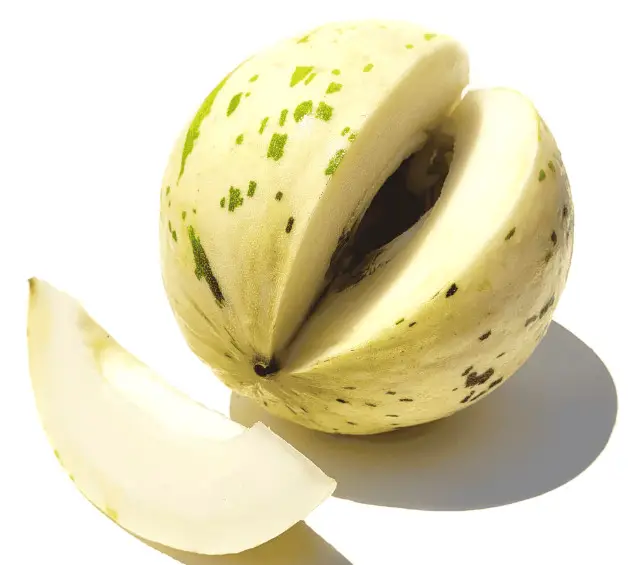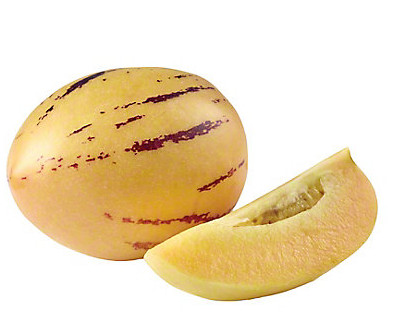Picasso melons, with their vibrant appearance and exquisite flavor, are a unique addition to any garden or homegrown produce collection. If you’re intrigued by the idea of cultivating these artistic fruits and ensuring they thrive, you’ve come to the right place. In this comprehensive guide, we’ll walk you through the entire process of growing and caring for Picasso melons, from selecting the right seeds to harvesting your bountiful crop.
Origin and taste of Picasso melons
Picasso melons, also known as Piel de Sapo melons or Santa Claus melons, are a type of melon that originated in Spain. They are named “Piel de Sapo,” which translates to “Toad Skin” in Spanish, due to their rough, greenish-brown rind that resembles the texture of a toad’s skin. These melons are believed to have been first cultivated in the region of Murcia in southeastern Spain.
In terms of taste, Picasso melons are known for their sweet and refreshing flavor. They have pale green to white flesh that is tender and juicy. The taste is often described as a combination of honeydew and cantaloupe, with a slightly tropical and floral undertone. The flesh has a crisp, succulent texture that makes it a popular choice for snacking, desserts, and fruit salads.

Picasso melons are typically harvested when they are fully mature but still firm. They are usually ready to be enjoyed during the summer months, making them a delightful treat during the hot weather. These melons are popular in Spain and are also exported to other countries, so you may find them in select markets and grocery stores worldwide during their peak season.
Picasso melons are aptly named after the famous artist Pablo Picasso due to their striking appearance. Their skin is a work of art, boasting a vibrant mix of green, yellow, and orange hues, reminiscent of Picasso’s bold color palette. When you slice into a Picasso melon, you’re greeted with a stunning display of artistic patterns, making it a true visual delight on your plate.
Choosing the Right Picasso Melon Seeds
Selecting the right Picasso melon seeds is the first and crucial step in your journey to growing these exceptional fruits successfully. With several varieties available, each offering its own unique characteristics, it’s important to make an informed choice that suits your climate and preferences. In this section, we’ll explore the key factors to consider when choosing Picasso melon seeds.

Picasso melons come in various varieties, each with its own flavor profile, size, and growth requirements. Here are some popular Picasso melon varieties to consider:
– Picasso Gold: Known for its sweet, tropical flavor and vibrant orange flesh, Picasso Gold is a favorite among melon enthusiasts. It thrives in warm climates and produces medium-sized fruits.
– Picasso Red: This variety boasts a striking red flesh with a flavor that’s both sweet and slightly tangy. Picasso Red melons are known for their refreshing taste and adaptability to various growing conditions.
– Picasso Green: If you prefer a mellower, honeydew-like flavor, Picasso Green is an excellent choice. These melons have pale green flesh and are perfect for cooler climates.
– Mini Picasso: If you have limited space or want to grow melons in containers, consider Mini Picasso. These compact plants yield small, sweet melons that are perfect for snacking
Understanding Picasso Melon Requirements
Climate Compatibility: Picasso melons thrive in warm, sunny climates with plenty of sunlight. Before selecting your seeds, consider your local climate and growing season. Certain varieties may be better suited to your region’s conditions, so research the optimal varieties for your area to ensure a successful harvest.
Disease Resistance: Check for disease-resistant varieties, especially if you’re growing Picasso melons in an area prone to specific melon diseases. Disease-resistant varieties can help reduce the risk of plant infections and increase your chances of a healthy crop.
Seed Quality: Choose high-quality seeds from reputable sources or nurseries. Ensure the seeds are fresh, free from damage, and properly stored. Look for information on the seed packet or from the supplier about the seed’s germination rate and any specific planting instructions.
Personal Preferences: Consider your own taste preferences when selecting Picasso melon seeds. Do you prefer sweeter or more tangy melons? Are you interested in trying different varieties for a variety of flavors? Your personal taste should influence your seed selection.
Space and Growing Method: Evaluate your available space and growing method. If you have a small garden or plan to grow in containers, choose varieties that are more compact or suitable for confined spaces. Conversely, if you have ample garden space, you can experiment with larger varieties.
Growing Duration: Some Picasso melon varieties have shorter or longer growing durations. Depending on your climate and growing season length, select varieties that align with your available time for cultivation.
By carefully considering these factors, you can choose the right Picasso melon seeds that align with your preferences and local growing conditions. This thoughtful selection process is the foundation for a successful and rewarding Picasso melon growing experience. Once you’ve made your choice, you’ll be well on your way to cultivating these artful and delicious fruits in your own garden.
Planting Picasso Melons
Preparing the Soil
The success of your Picasso melon cultivation journey hinges significantly on the quality of the soil in which you plant them. Proper soil preparation ensures that your melon plants have the necessary nutrients and conditions to flourish.
Begin by selecting a well-drained area in your garden or the right-sized containers if you’re planning to grow them in pots. Picasso melons thrive in sunny locations with plenty of sunlight, so choose a spot that receives at least 6-8 hours of sunlight daily.
Before planting, it’s essential to enrich the soil with organic matter. Compost or well-rotted manure is excellent for enhancing soil fertility. Work this organic material into the soil to a depth of at least 12 inches. This will not only provide essential nutrients but also improve the soil’s ability to retain moisture, which is crucial for healthy melon growth.
Consider conducting a soil test to determine the pH level of your soil. Picasso melons prefer a slightly acidic to neutral pH (around 6.0 to 7.0). If your soil’s pH is not within this range, you may need to make amendments to adjust it accordingly.
Sowing Picasso Melon Seeds
Once your soil is well-prepared, it’s time to sow your Picasso melon seeds. Proper sowing techniques are crucial to give your melon plants the best start.
Spacing: Pay close attention to spacing. Picasso melon vines tend to spread out generously, so it’s vital to provide them with ample room to grow. Plant the seeds or seedlings at least 2-3 feet apart in rows, with rows spaced approximately 4-6 feet apart. This spacing allows for proper air circulation and prevents overcrowding.
Depth: When sowing the seeds, plant them at a depth of about 1 inch. Ensure the soil is well-moistened before sowing to encourage germination. Keep in mind that Picasso melons prefer warm soil, so make sure the soil temperature is consistently above 60°F (15°C) for successful germination.
After sowing, gently water the area to settle the soil around the seeds. Maintain consistent moisture throughout the germination period, which usually takes about 7-10 days. Once the seedlings emerge and grow their first true leaves, you can thin them if necessary, leaving the healthiest plants at the recommended spacing.
By properly preparing your soil and sowing Picasso melon seeds with care, you’re well on your way to cultivating healthy and productive melon plants. In the following sections, we will delve deeper into caring for your growing melons and troubleshooting common issues.
Caring for Picasso Melon Plants
Once you’ve successfully prepared the soil and sown your Picasso melon seeds, it’s time to focus on the care and maintenance of your melon plants. In this chapter, we’ll delve into various aspects of nurturing your melon crop to ensure a bountiful and healthy harvest.
Watering Requirements
Proper watering is crucial for the well-being of your Picasso melon plants. Discover the right balance between hydration and avoiding waterlogged soil. Melon plants require consistent moisture, especially during their growing and fruiting stages. It’s essential to water deeply, ensuring the moisture reaches the root zone. However, avoid overwatering, as excessively wet soil can lead to root rot and other problems. Learn how to assess soil moisture levels and establish a regular watering schedule that meets your melon plants’ needs.
Fertilizing Picasso Melons
Nutrient-rich soil is the foundation of healthy melon plants. In this section, we’ll explore fertilization techniques and schedules to ensure your melons have access to the essential nutrients they require for robust growth. Understanding the specific nutrient needs of Picasso melons at different stages of development is vital. Learn how to select the right fertilizers, apply them correctly, and monitor your plants’ response to ensure they thrive.
Managing Pests and Diseases
Picasso melon plants, like all crops, can be susceptible to various pests and diseases. This section will help you identify common threats that can affect your melon plants and provide insights into organic methods to manage and prevent these issues. By implementing proper pest and disease management strategies, you can protect your melon crop and promote its overall health without resorting to harmful chemicals.
Supporting Melon Vines
As your Picasso melon plants mature and begin to produce fruit, the weight of the melons can strain the vines. Proper support is essential to prevent damage to the vines and ensure a successful harvest. Learn how to provide the necessary support for your melon vines, including trellising and using slings to cradle developing melons. Proper support not only protects the plants but also promotes air circulation, reducing the risk of diseases.
By mastering the care techniques outlined in Chapter 3, you’ll be well-equipped to nurture your Picasso melon plants from seed to harvest. With dedication and attention to detail, you can look forward to enjoying the sweet rewards of your labor when the melons ripen and are ready for picking.
Picasso Melon Care during Growth
As your Picasso melon plants continue to grow, it’s crucial to provide them with the care they need to thrive and produce abundant, high-quality fruit. In this section, we’ll explore two essential practices to ensure the health and productivity of your melon crop.
Thinning Melon Plants
Thinning your melon plants is a fundamental practice that often gets overlooked but plays a vital role in promoting healthier growth and more substantial fruit production. Thinning involves the selective removal of excess melon seedlings or developing fruits from each plant.
Why is thinning important? Overcrowding can lead to competition for nutrients, water, and sunlight among melon plants. When plants are too densely packed, they may not receive the resources they need to produce large, sweet melons. Thinning allows the remaining melon plants to benefit from increased access to these essential resources.
To thin your Picasso melon plants, start by identifying the healthiest and most vigorous seedlings or developing fruits. These are the ones with the greatest potential to produce high-quality melons. Carefully remove weaker seedlings or fruits, leaving adequate space (typically about 2-3 feet apart) between the chosen ones. Thinning should be done when the seedlings have at least two or three true leaves and are strong enough to withstand the process.
By thinning your melon plants, you’re ensuring that each plant has the best chance to flourish and yield delicious fruit. It may seem counterintuitive to remove some plants, but the resulting stronger, healthier plants will ultimately produce more and better melons.
Pruning Melon Vines
Pruning is another essential practice in Picasso melon care. Pruning involves selectively removing excess foliage and non-essential branches to direct the plant’s energy towards fruit development.
The primary goal of pruning is to improve air circulation and sunlight penetration into the interior of the plant. This helps reduce the risk of diseases and promotes even ripening of the melons. Additionally, pruning can prevent the plant from becoming overly dense, which can make it difficult to access the fruit and may lead to smaller melons.
To prune your Picasso melon vines effectively, use clean, sharp pruning shears or scissors. Start by removing any dead or diseased leaves or branches. Then, selectively trim back excessive foliage and side shoots, especially those growing along the main vine. Focus on maintaining a single, strong central vine with a few well-spaced side branches.
Remember that pruning should be done judiciously, and it’s best to avoid excessive removal of foliage, as the leaves play a crucial role in photosynthesis. Pruning should be performed during the growing season, typically when the vines are actively producing but before the fruits begin to ripen.
By mastering the art of thinning and pruning your Picasso melon plants, you’ll encourage healthier growth, larger and sweeter melons, and an overall more successful harvest. These practices, when combined with the care techniques discussed earlier, will help you cultivate a thriving melon crop.
Harvesting and Storing Picasso Melons
After nurturing your Picasso melon plants from seed to maturity, the time has come to reap the rewards of your efforts. In this section, we’ll delve into the critical aspects of harvesting and storing your Picasso melons to ensure they reach your plate at their peak of flavor and freshness.
Determining Ripeness
The first step in harvesting Picasso melons is mastering the art of recognizing when they are ripe for picking. Picking melons at the right moment ensures the best possible flavor and sweetness. To determine ripeness, consider the following indicators:
Color: Examine the color of the melon’s skin. For Picasso melons, the skin should have transformed from its greenish-brown, rough texture to a vibrant yellowish-green. Look for even coloring without any significant patches of green.
Texture: Gently press the end opposite the stem (known as the blossom end) of the melon. It should yield slightly to gentle pressure, indicating ripeness. The skin should feel firm but not hard. Avoid melons that are too soft, as they may be overripe.
Smell: Bring the melon close to your nose and take a sniff. A ripe Picasso melon should emit a sweet, fruity fragrance. If it lacks a noticeable aroma, it may not be fully ripe.
Harvesting Picasso Melons
Once you’ve determined that your Picasso melons are ripe, it’s time to harvest them carefully to avoid damaging the precious fruit. Follow these harvesting techniques to ensure a successful harvest:
Use Pruning Shears or a Sharp Knife: Rather than pulling or twisting the melons from the vine, use clean pruning shears or a sharp knife to cut the stem about an inch above the fruit. This minimizes stress on the vine and prevents damage to the melon.
Handle with Care: Handle the melons gently to prevent bruising or scratching the skin. Melons are delicate, and even minor damage can impact their shelf life.
Harvest in the Morning: It’s best to harvest Picasso melons in the morning when temperatures are cooler. This helps preserve the melon’s crispness and flavor.
Storing Picasso Melons
Once harvested, it’s essential to store your Picasso melons properly to maintain their freshness and flavor. Proper storage techniques differ depending on whether you plan to consume them shortly or store them for an extended period. Here are some tips for both scenarios:
Short-Term Storage (Up to a Week)
– Store at room temperature: Keep ripe melons at room temperature for up to a week.
– Keep out of direct sunlight: Protect them from direct sunlight, which can cause overripening.
– Check regularly: Inspect stored melons for any signs of softening or spoilage and consume promptly.
Long-Term Storage (Several Weeks)
– Refrigerate: If you need to store Picasso melons for an extended period, place them in the refrigerator. Use a perforated plastic bag or wrap them in plastic wrap to retain moisture.
– Keep humidity low: Maintain low humidity in the refrigerator to prevent moisture buildup, which can lead to mold.
– Prioritize freshness: Try to consume refrigerated melons within two to three weeks for the best flavor and texture.
By understanding when to harvest and how to store your Picasso melons, you’ll maximize their quality and enjoy the sweet, refreshing taste that makes these melons so popular. Harvesting and storing with care are the final steps in your journey to savoring the fruits of your labor as a successful melon grower.
Enjoying Picasso Melons
As you savor the delightful results of your hard work and dedication in growing and harvesting Picasso melons, it’s time to explore the various ways you can enjoy these sweet and refreshing fruits. In this section, we’ll delve into both the culinary uses and nutritional benefits of Picasso melons, making your melon experience even more enjoyable.
Culinary Uses
Picasso melons are not only known for their exquisite flavor but also their versatility in the kitchen. Discover delicious recipes and creative ways to incorporate Picasso melons into your meals and snacks. Here are some culinary ideas to get you started:
Fresh Melon Slices: The simplest way to enjoy Picasso melons is by slicing them and relishing their sweet, juicy flesh. Serve them as a refreshing snack or side dish.
Melon Salads: Dice Picasso melons and add them to fruit salads or combine them with cucumbers, red onions, and mint for a refreshing summer salad.
Smoothies and Beverages: Blend Picasso melon chunks with yogurt, honey, and a touch of lime juice for a delightful melon smoothie. You can also puree them to make melon agua fresca or cocktails.
Melon Sorbet: Freeze melon puree with a bit of sugar to create a homemade melon sorbet that’s perfect for cooling down on hot days.
Melon Salsa: Dice Picasso melons and mix them with red onion, jalapeño, cilantro, and lime juice for a unique and flavorful melon salsa that pairs well with grilled chicken or fish.
Desserts: Incorporate melon chunks into desserts like fruit tarts, ice cream, or panna cotta for a sweet twist.
Nutritional Benefits of Picasso melons
Beyond their delectable taste, Picasso melons offer a range of nutritional benefits that make them a valuable addition to your diet. Here’s a glimpse of the nutritional value of these melons:
Hydration: Picasso melons have a high water content, making them an excellent choice for staying hydrated, especially during hot weather.
Vitamins and Minerals: They are a good source of vitamins A and C, both of which support skin health, immune function, and vision. Additionally, they contain essential minerals like potassium, which aids in regulating blood pressure.
Fiber: Picasso melons provide dietary fiber, which promotes digestive health and helps maintain regular bowel movements.
Low in Calories: These melons are relatively low in calories, making them a healthy snack option for those watching their calorie intake.
Antioxidants: Like many fruits, Picasso melons contain antioxidants that can help protect your cells from oxidative stress and reduce the risk of chronic diseases.
By exploring the culinary uses and recognizing the nutritional benefits of Picasso melons, you can make the most of these delicious fruits in your daily meals and snacks while promoting a healthier lifestyle. Whether you enjoy them on their own or incorporate them into your favorite dishes, Picasso melons are a delightful addition to any kitchen and a celebration of your successful melon-growing journey.
Conclusion
In conclusion, cultivating and caring for Picasso melons can be a rewarding experience for gardeners and food enthusiasts alike. With the right knowledge and attention, you can enjoy the artful beauty and exquisite flavor of Picasso melons straight from your garden. Follow this comprehensive guide, and you’ll be on your way to growing and caring for Picasso melons like a seasoned expert.






